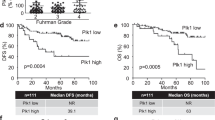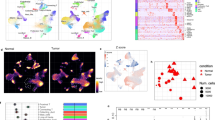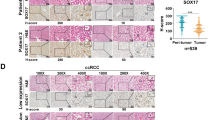Abstract
The macrophage migration inhibitory factor (MIF) is a hypoxia regulated gene that has a variety of tumorigenic functions. In clear cell renal carcinoma (CCRC), hypoxic signaling is constitutively active because of the frequent loss of function of the von Hippel-Lindau tumor suppressor protein. We therefore sought to assess the expression of MIF in CCRC and its biological functions. We stained tumor tissue microarrays comprising sections of 128 CCRC tumors and found MIF to be moderately or highly expressed in >98%. MIF expression was further found to be dramatically elevated in blood plasma of individuals with CCRC compared with healthy controls, suggesting that measurement of MIF levels in the blood may have utility as a diagnostic marker in CCRC. At a functional level, MIF has been reported to engage the CD74 and CD44 receptors and induce signal transduction. In CCRC cell lines, depletion of MIF, CD74 or CD44 by small hairpin RNA led to a significant reduction in growth rate, and clonogenic survival, coinciding with the degree of knockdown. Interruption of the MIF pathway also decreased tumorigenic potential. Biochemically, we found that in CCRC cells MIF signaling leads to activation of the mitogen-activated protein kinase pathway and to Src phosphorylation, which is critical for regulation of p27. Together, our studies establish MIF as a protumorigenic signaling molecule that functions in an autocrine fashion to promote renal cell carcinoma and may be useful as a minimally invasive marker of disease status.
This is a preview of subscription content, access via your institution
Access options
Subscribe to this journal
Receive 50 print issues and online access
$259.00 per year
only $5.18 per issue
Buy this article
- Purchase on Springer Link
- Instant access to full article PDF
Prices may be subject to local taxes which are calculated during checkout




Similar content being viewed by others
References
American Cancer Society. Cancer Facts & Figures 2011. Atlanta, Ga: American Cancer Society, 2011.
Kaelin WG, Ratcliffe PJ . Oxygen sensing by metazoans: the central role of the HIF hydroxylase pathway. Mol Cell 2008; 30: 393–402.
Kondo K, Klco J, Nakamura E, Lechpammer M, Kaelin WG . Inhibition of HIF is necessary for tumor suppression by the von Hippel-Lindau protein. Cancer Cell 2002; 1: 237–246.
Kim WY, Kaelin WG . Role of VHL gene mutation in human cancer. J Clin Oncol 2004; 22: 4991–5004.
Bach JP, Rinn B, Meyer B, Dodel R, Bacher M . Role of MIF in inflammation and tumorigenesis. Oncology 2008; 75: 127–133.
David JR. . Delayed hypersensitivity in vitro: its mediation by cell-free substances formed by lymphoid cell-antigen interaction. Proc Natl Acad Sci USA 1966; 56: 72–77.
Calandra T, Bernhagen J, Metz CN, Spiegel LA, Bacher M, Donnelly T et al. MIF as a glucocorticoid-induced modulator of cytokine production. Nature 1995; 377: 68–71.
Lue H, Thiele M, Franz J, Dahl E, Speckgens S, Leng L et al. Macrophage migration inhibitory factor (MIF) promotes cell survival by activation of the Akt pathway and role for CSN5/JAB1 in the control of autocrine MIF activity. Oncogene 2007; 26: 5046–5059.
Kleemann R, Hausser A, Geiger G, Mischke R, Burger-Kentischer A, Flieger O et al. Intracellular action of the cytokine MIF to modulate AP-1 activity and the cell cycle through Jab1. Nature 2000; 408: 211–216.
Lue H, Kapurniotu A, Fingerle-Rowson G, Roger T, Leng L, Thiele M et al. Rapid and transient activation of the ERK MAPK signalling pathway by macrophage migration inhibitory factor (MIF) and dependence on JAB1/CSN5 and Src kinase activity. Cell Signal 2006; 18: 688–703.
Amin MA, Haas CS, Zhu K, Mansfield PJ, Kim MJ, Lackowski NP et al. Migration inhibitory factor up-regulates vascular cell adhesion molecule-1 and intercellular adhesion molecule-1 via Src, PI3 kinase, and NFkappaB. Blood 2006; 107: 2252–2261.
Bacher M, Schrader J, Thompson N, Kuschela K, Gemsa D, Waeber G et al. Up-regulation of macrophage migration inhibitory factor gene and protein expression in glial tumor cells during hypoxic and hypoglycemic stress indicates a critical role for angiogenesis in glioblastoma multiforme. Am J Pathol 2003; 162: 11–17.
Baugh JA, Gantier M, Li L, Byrne A, Buckley A, Donnelly SC . Dual regulation of macrophage migration inhibitory factor (MIF) expression in hypoxia by CREB and HIF-1. Biochem Biophys Res Commun 2006; 347: 895–903.
Koong AC, Denko NC, Hudson KM, Schindler C, Swiersz L, Koch C et al. Candidate genes for the hypoxic tumor phenotype. Cancer Res 2000; 60: 883–887.
Welford SM, Bedogni B, Gradin K, Poellinger L, Broome Powell M, Giaccia AJ . HIF1alpha delays premature senescence through the activation of MIF. Genes Dev 2006; 20: 3366–3371.
He XX, Yang J, Ding YW, Liu W, Shen QY, Xia HH . Increased epithelial and serum expression of macrophage migration inhibitory factor (MIF) in gastric cancer: potential role of MIF in gastric carcinogenesis. Gut 2006; 55: 797–802.
Hira E, Ono T, Dhar DK, El-Assal ON, Hishikawa Y, Yamanoi A et al. Overexpression of macrophage migration inhibitory factor induces angiogenesis and deteriorates prognosis after radical resection for hepatocellular carcinoma. Cancer 2005; 103: 588–598.
Meyer-Siegler KL, Bellino MA, Tannenbaum M . Macrophage migration inhibitory factor evaluation compared with prostate specific antigen as a biomarker in patients with prostate carcinoma. Cancer 2002; 94: 1449–1456.
He XX, Chen K, Yang J, Li XY, Gan HY, Liu CY et al. Macrophage migration inhibitory factor promotes colorectal cancer. Mol Med 2009; 15: 1–10.
Shimizu T, Abe R, Nakamura H, Ohkawara A, Suzuki M, Nishihira J . High expression of macrophage migration inhibitory factor in human melanoma cells and its role in tumor cell growth and angiogenesis. Biochem Biophys Res Commun 1999; 264: 751–758.
Kamimura A, Kamachi M, Nishihira J, Ogura S, Isobe H, Dosaka-Akita H et al. Intracellular distribution of macrophage migration inhibitory factor predicts the prognosis of patients with adenocarcinoma of the lung. Cancer 2000; 89: 334–341.
Xia HH, Yang Y, Chu KM, Gu Q, Zhang YY, He H et al. Serum macrophage migration-inhibitory factor as a diagnostic and prognostic biomarker for gastric cancer. Cancer 2009; 115: 5441–5449.
Legendre H, Decaestecker C, Nagy N, Hendlisz A, Schuring MP, Salmon I et al. Prognostic values of galectin-3 and the macrophage migration inhibitory factor (MIF) in human colorectal cancers. Mod Pathol 2003; 16: 491–504.
Leng L, Metz CN, Fang Y, Xu J, Donnelly S, Baugh J et al. MIF signal transduction initiated by binding to CD74. J Exp Med 2003; 197: 1467–1476.
Shi X, Leng L, Wang T, Wang W, Du X, Li J et al. CD44 is the signaling component of the macrophage migration inhibitory factor-CD74 receptor complex. Immunity 2006; 25: 595–606.
Bernhagen J, Krohn R, Lue H, Gregory JL, Zernecke A, Koenen RR et al. MIF is a noncognate ligand of CXC chemokine receptors in inflammatory and atherogenic cell recruitment. Nat Med 2007; 13: 587–596.
Maxwell PH, Wiesener MS, Chang GW, Clifford SC, Vaux EC, Cockman ME et al. The tumour suppressor protein VHL targets hypoxia-inducible factors for oxygen-dependent proteolysis. Nature 1999; 399: 271–275.
Krieg M, Haas R, Brauch H, Acker T, Flamme I, Plate KH . Up-regulation of hypoxia-inducible factors HIF-1alpha and HIF-2alpha under normoxic conditions in renal carcinoma cells by von Hippel-Lindau tumor suppressor gene loss of function. Oncogene 2000; 19: 5435–5443.
Lubetsky JB, Dios A, Han J, Aljabari B, Ruzsicska B, Mitchell R et al. The tautomerase active site of macrophage migration inhibitory factor is a potential target for discovery of novel anti-inflammatory agents. J Biol Chem 2002; 277: 24976–24982.
Mitchell RA, Liao H, Chesney J, Fingerle-Rowson G, Baugh J, David J et al. Macrophage migration inhibitory factor (MIF) sustains macrophage proinflammatory function by inhibiting p53: regulatory role in the innate immune response. Proc Natl Acad Sci USA 2002; 99: 345–350.
Nguyen MT, Lue H, Kleemann R, Thiele M, Tolle G, Finkelmeier D et al. The cytokine macrophage migration inhibitory factor reduces pro-oxidative stress-induced apoptosis. J Immunol 2003; 170: 3337–3347.
Li GQ, Xie J, Lei XY, Zhang L . Macrophage migration inhibitory factor regulates proliferation of gastric cancer cells via the PI3K/Akt pathway. World J Gastroenterol 2009; 15: 5541–5548.
Schrader J, Deuster O, Rinn B, Schulz M, Kautz A, Dodel R et al. Restoration of contact inhibition in human glioblastoma cell lines after MIF knockdown. BMC Cancer 2009; 9: 464.
Onodera S, Nishihira J, Iwabuchi K, Koyama Y, Yoshida K, Tanaka S et al. Macrophage migration inhibitory factor up-regulates matrix metalloproteinase-9 and -13 in rat osteoblasts. Relevance to intracellular signaling pathways. J Biol Chem 2002; 277: 7865–7874.
Chu I, Sun J, Arnaout A, Kahn H, Hanna W, Narod S et al. p27 phosphorylation by Src regulates inhibition of cyclin E-Cdk2. Cell 2007; 128: 281–294.
Gordan JD, Lal P, Dondeti VR, Letrero R, Parekh KN, Oquendo CE et al. HIF-alpha effects on c-Myc distinguish two subtypes of sporadic VHL-deficient clear cell renal carcinoma. Cancer Cell 2008; 14: 435–446.
Acknowledgements
This work was funded by CA147387, and by an RSG from the American Cancer Society (121762-RSG-12-097-01-CCG) to SMW. We thank Drs Amato Giaccia and Haifeng Yang for cell lines. Flow cytometry was performed in the CASE Comprehensive Cancer Center Cytometry and Microscopy Core facility, which is supported by P30CA43703.
Author information
Authors and Affiliations
Corresponding author
Ethics declarations
Competing interests
The authors declare no conflicts of interest.
Additional information
Supplementary Information accompanies the paper on the Oncogene website
Rights and permissions
About this article
Cite this article
Du, W., Wright, B., Li, X. et al. Tumor-derived macrophage migration inhibitory factor promotes an autocrine loop that enhances renal cell carcinoma. Oncogene 32, 1469–1474 (2013). https://doi.org/10.1038/onc.2012.143
Received:
Revised:
Accepted:
Published:
Issue Date:
DOI: https://doi.org/10.1038/onc.2012.143
Keywords
This article is cited by
-
Macrophage migration inhibitory factor is regulated by HIF-1α and cAMP and promotes renal cyst cell proliferation in a macrophage-independent manner
Journal of Molecular Medicine (2020)
-
MIF family proteins in genitourinary cancer: tumorigenic roles and therapeutic potential
Nature Reviews Urology (2019)
-
ASK1/JNK-mediated TAp63 activation controls the cell survival signal of baicalein-treated EBV-transformed B cells
Molecular and Cellular Biochemistry (2016)
-
Macrophage migration inhibitory factor - a therapeutic target in gallbladder cancer
BMC Cancer (2015)
-
Prognostic value of several biomarkers for the patients with malignant pleural mesothelioma
Tumor Biology (2015)



